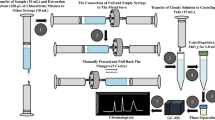Abstract
Oxidative damage due to low levels of glutathione (GSH) is one of the main causes of cataract formation. It has been reported that 2-oxothiazolidine-4-carboxylic acid (OTZ), a cysteine prodrug, can increase the cellular level of GSH. Currently, there is no analytical method to separate and quantify OTZ from aqueous humour samples for cataract research. The present study aims to develop and validate a hydrophilic interaction liquid chromatography (HILIC) method for the quantification of OTZ in simulated aqueous humour (SAH). The developed method was validated according to FDA guidelines. Accuracy, precision, selectivity, sensitivity, linearity, lower limit of quantification (LLOQ), lower limit of detection (LLOD) and stability were the parameters assessed in the method validation. The developed method was found to be accurate and precise with LLOQ and LLOD of 200 and 100 ng/mL, respectively; method selectivity was confirmed by the absence of any matrix interference with the analyte peak. The constructed calibration curve was linear in the range of 0.2–10 μg/mL, with a regression coefficient of 0.999. In addition, the OTZ was found to be stable in SAH after three freeze/thaw cycles. Chitosan nanoparticles loaded with OTZ were formulated by the ionic gelation method. The nanoparticles were found to be uniform in shape and well dispersed with average size of 153 nm. The in vitro release of OTZ from the nanoparticles was quantified using the developed analytical method over 96 h. Permeation of OTZ through excised bovine cornea was measured using HILIC. The lag time and the flux were 0.2 h and 3.05 μg/cm2 h, respectively.


Similar content being viewed by others

References
Vita JA, Frei B, Holbrook M, Gokce N, Leaf C, Keaney JF Jr (1998) L-2-Oxothiazolidine-4-carboxylic acid reverses endothelial dysfunction in patients with coronary artery disease. J Clin Invest 101(6):1408–1414
Al-Kinani AA, Calabrese G, Vangala A, Naughton D, Alany RG (2012) In: Souto EB (ed) Patenting nanomedicines, vol 1. Springer, Berlin
Chirila TV, Morrison DA, Gridneva Z, Meyrick D, Hicks CR, Webb JM (2005) Effect of multipurpose solutions for contact lens care on the in vitro drug-induced spoliation of poly(2-hydroxyethyl methacrylate) in simulated aqueous humour. Cont Lens Anterior Eye 28(1):21–28
Calvo P, Remuñán-López C, Vila-Jato JL, Alonso MJ (1997) Novel hydrophilic chitosan-polyethylene oxide nanoparticles as protein carriers. J Appl Polym Sci 63(1):125–132
Theodoropoulos D, Rova A, Smith JR, Barbu E, Calabrese G, Vizirianakis IS, Tsibouklis J, Fatouros DG (2013) Towards boron neutron capture therapy: the formulation and preliminary in vitro evaluation of liposomal vehicles for the therapeutic delivery of the dequalinium salt of bis-nido-carborane. Bioorg Med Chem Lett 23(22):6161–6166
Gwilt P, Radick L, Li X, Whalen J, Leaf C (1998) Pharmacokinetics of 2-oxothiazolidine-4-carboxylate, a cysteine prodrug, and cysteine. J Clin Pharmacol 38:945–950
Buszewski B, Noga S (2012) Hydrophilic interaction liquid chromatography (HILIC)-a powerful separation technique. Anal Bioanal Chem 402(1):231–247
Cubbon S, Bradbury T, Wilson J, Thomas-Oates J (2007) Hydrophilic interaction chromatography for mass spectrometric metabonomic studies of urine. Anal Chem 79(23):8911–8918
Eaton P, West P (2010) Atomic force microscopy. Oxford University Press, Oxford
Keawchaoon L, Yoksan R (2011) Preparation, characterization and in vitro release study of carvacrol-loaded chitosan nanoparticles. Colloids Surf B: Biointerfaces 84(1):163–171
Acknowledgments
The authors would like to thank Kingston University London, Faculty of Science, Engineering and Computing for providing Mr. Ali Athab Al-Kinani with a Ph.D. scholarship. Also, we would like to thank Dr. Julian Swinden, Richard Giddens and Wendy Brosnan for their technical support. Sodium hyaluronate (from bovine vitreous humour) was kindly gifted from Sigma-Aldrich (Dorset, UK).
Author information
Authors and Affiliations
Corresponding author
Rights and permissions
About this article
Cite this article
Al-Kinani, A.A., Naughton, D.P., Calabrese, G. et al. Analysis of 2-oxothiazolidine-4-carboxylic acid by hydrophilic interaction liquid chromatography: application for ocular delivery using chitosan nanoparticles. Anal Bioanal Chem 407, 2645–2650 (2015). https://doi.org/10.1007/s00216-015-8494-8
Received:
Revised:
Accepted:
Published:
Issue Date:
DOI: https://doi.org/10.1007/s00216-015-8494-8



